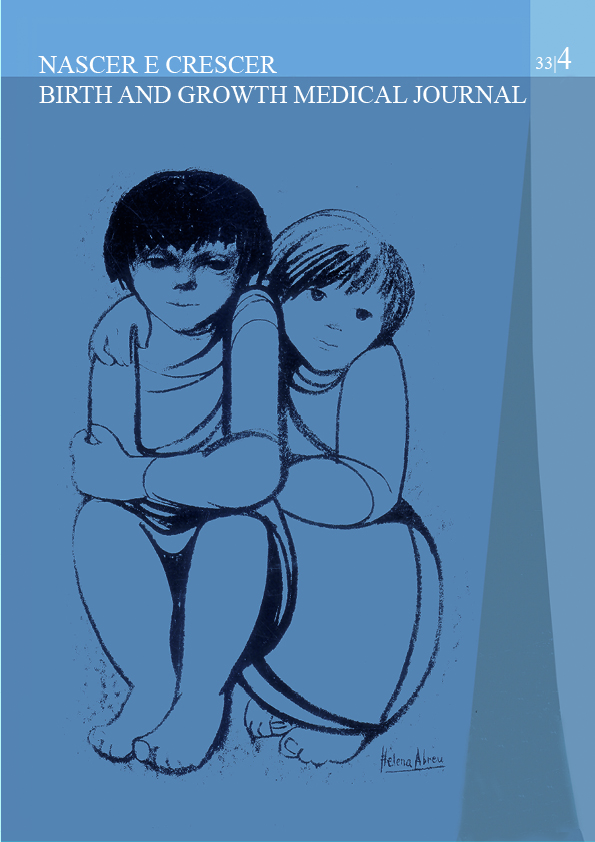Wieacker-Wolff syndrome - A rare X-linked hereditary disorder
DOI:
https://doi.org/10.25753/BirthGrowthMJ.v33.i4.33195Keywords:
arthrogryposis, hypotonia, intellectual disability, Wieacker-Wolff syndrome, ZC4H2 geneAbstract
Wieacker-Wolff syndrome (WWS) is an X-linked disorder caused by a pathogenic mutation in the ZC4H2 gene. It affects both the central and peripheral nervous systems.
The authors describe the case of a six-year-old boy with global developmental delay since the age of four months, with marked axial hypotonia. He had a history of bilateral clubfoot, feeding difficulties, and recurrent respiratory infections. Physical examination revealed a long and flat philtrum, low-set ears, arched palate, and a carp-shaped mouth. The child currently has intellectual disability, epilepsy, and lower limb spasticity. Clinical exome sequencing revealed the presence of a mutation in the ZC4H2 gene, confirming the diagnosis of WWS, a rare condition.
With this case, the authors intend to highlight the importance of evaluating early signs of musculoskeletal deformities and hypotonia in the first months of life. Besides confirming the etiologic diagnosis, the genetic study allows to anticipate associated conditions, tailor interventions, and provide family counseling.
Downloads
References
Wieacker P, Wolff G, Wienker TF, Sauer M. A new X-linked syndrome with muscle atrophy, congenital contractures, and oculomotor apraxia. American journal of medical genetics. 1985; 20(4): 597–606. https://doi.org/10.1002/ajmg.1320200405.
Orphanet: an online database of rare diseases and orphan drugs. Copyright, INSERM 1997. Assessed June 12, 2022. Available:https://www.orpha.net/consor/www/cgi-bin/Disease_Search.php?lng=EN&data_id=3036&MISSING%20CONTENT=Wieacker-Wolff-syndrome&search=Disease_Search_Simple&title=Wieacker-Wolff-syndrome.
ZC4H2-Associated Rare Disorders (ZARD): National Organization for Rare Disorders (NORD). Assessed June 12, 2022. Available: https://rarediseases.org/rare-diseases/wieacker-syndrome/.
Frints SGM, Hennig F, Colombo R, Jacquemont S, Terhal P, et al. Deleterious de novo variants of X-linked ZC4H2 in females cause a variable phenotype with neurogenic arthrogryposis multiplex congenita. Human mutation. 2019. 40(12):2270–2285. https://doi.org/10.1002/humu.23841.
Kloos DU, Jakubiczka S, Wienker T, Wolff G, & Wieacker P. Localization of the gene for Wieacker-Wolff syndrome in the pericentromeric region of the X chromosome. Human Genetics. 1997; 100, 426–430. https://doi.org/10.1007/s004390050528.
Hirata H, Nanda I, van Riesen A, McMichael G, Hu H, Hambrock M, et al. ZC4H2 mutations are associated with arthrogryposis multiplex congenita and intellectual disability through impairment of central and peripheral synaptic plasticity. American journal of human genetics. 2013. 92(5):681–695. https://doi.org/10.1016/j.ajhg.2013.03.021.
Online Mendelian Inheritance in Man, OMIM®. McKusick-Nathans Institute of Genetic Medicine, Johns Hopkins University (Baltimore, MD), 2022. Assessed June 12, 2022. Available: Worldwide URL: https://omim.org/entry/314580 [10-06-2022].
Hirata H, Nanda I, van Riesen A, McMichael G, Hu H, Hambrock M, et al. ZC4H2 mutations are associated with arthrogryposis multiplex congenita and intellectual disability through impairment of central and peripheral synaptic plasticity. American journal of human genetics 2013. 92(5):681–695. https://doi.org/10.1016/j.ajhg.2013.03.021.
Wang D, Hu D, Guo Z, Hu R, Wang Q, Liu Y, et al. A novel de novo nonsense mutation in ZC4H2 causes Wieacker-Wolff Syndrome. Molecular genetics & genomic medicine. 2020: 8(2):e1100. https://doi.org/10.1002/mgg3.1100.
May M, Hwang K-S, Miles J, Williams C, Niranjan T, Kahler SG, et al. ZC4H2, an XLID gene, is required for the generation of a specific subset of CNS interneurons. Hum. Molec. Genet. 2015. 24: 4848-4861. https://doi.org/10.1093/hmg/ddv208.
Okubo Y, Endo W, Inui T, Suzuki-Muromoto S, Miyabayashi T, Togashi N, et al. A severe female case of arthrogryposis multiplex congenita with brain atrophy, spastic quadriplegia and intellectual disability caused by ZC4H2 mutation. 2018. Brain Dev. 40: 334-338. https://doi.org/10.1016/j.braindev.2017.11.011.
Zanzottera C, Milani D, Alfei E, Rizzo A, D’Arrigo S, Esposito S, et al. ZC4H2 deletions can cause severe phenotype in female carriers. Am. J. Med. Genet. 2017. 173A: 1358-1363. https://doi.org/10.1002/ajmg.a.38155.
Deneufbourg C, Duquenne A, Biard J-M, Sznajer Y. Wieacker-Wolff syndrome, a distinctive phenotype of arthrogryposis multiplex congenita caused by a “de novo” ZC4H2 gene partial deletion. Clin Case Rep. 2021; 9:e04718. https://doi.org/10.1002/ccr3.4718.
Downloads
Published
How to Cite
Issue
Section
License
Copyright (c) 2025 Joao Dias

This work is licensed under a Creative Commons Attribution-NonCommercial 4.0 International License.
Copyright and Authors' Rights
All articles published in Nascer e Crescer - Birth and Growth Medical Journal are Open Access and comply with the requirements of funding agencies or academic institutions. For use by third parties, Nascer e Crescer - Birth and Growth Medical Journal adheres to the terms of the Creative Commons License "Attribution - Non-Commercial Use (CC-BY-NC)".
It is the author's responsibility to obtain permission to reproduce figures, tables, etc. from other publications.
Authors must submit a Conflict of Interest statement and an Authorship Form with the submission of the article. An e-mail will be sent to the corresponding author confirming receipt of the manuscript.
Authors are permitted to make their articles available in repositories at their home institutions, provided that they always indicate where the articles were published and adhere to the terms of the Creative Commons license.


